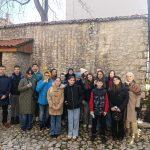The period of Ottoman rule in Bosnia and Herzegovina left an indelible mark on our history. For over five hundred years, the Turkish language written in Arabic script, alongside Arabic and Persian, was used in official correspondence. Consequently, the most important historical documents from that time were written in oriental languages.
The most significant collections from this period are preserved in Gazi Husrev-bey's Library, the Historical Archive of Sarajevo, and the National and University Library. The Oriental Institute, formed specifically for the collection and study of oriental heritage, was one of the first institutions to be destroyed by shell bomb attacks during the aggression in 1992.
The Museum of Sarajevo also houses a smaller yet culturally and museologically significant collection of oriental writings and objects, essential for researching the history of Sarajevo. The Oriental Collection was established in 1953, with the first exhibit entered in the inventory book being a beautifully illuminated, undated Quran, purchased for 40,000 dinars.
The first curator of the Oriental Collection was Derviš Korkut, who managed the collection from 1953 to 1963. Prior to this role, he worked as a curator and librarian at the National Museum of Bosnia and Herzegovina from 1937 to 1944, and is renowned for saving the Sarajevo Haggadah during World War II. The inventory book of the Oriental Collection, maintained by Korkut, is considered a small work of art. He wrote with a fountain pen in perfectly regular cursive handwriting, often using Arabic script for certain names.
After Korkut, the position of curator remained vacant until 1974, when Muniba Korkut Spaho took over and served until the retirement in 1984. From 1984 to 1988, the collection was managed by Nenad Filipović. Since 1990, Amra Madžarević has been overseeing the Oriental Collection.
Today, the Oriental Collection comprises about a hundred manuscripts in Arabic and Turkish, covering fields such as theology, Sharia law, linguistics, literature, history, and medicine. Among the most valuable exhibits are illuminated copies of handwritten Qurans, prayer book known as "Enam," a transcription of Muvekit's "Bosnian Chronicles," and Nidai’s Ljekaruša . This significant collection also includes register notebooks and individual documents, providing invaluable insights into the region's rich historical tapestry.
Among the registers is an accounting of Gazi Isa-beg's vakuf from 1819, the third book of the population census in Sarajevo from 1866, and the trade registers of the Kumašin family from Sarajevo. Also notable is the collection of thirty craft notebooks of the Čatić family, who were silk garment makers.
The collection of individual documents consists of firmans , beraths , levhas , and private legal documents, such as sales and other contracts. These documents mention old Sarajevan families and represent an important link in the study of both, the history of the capital of Bosnia and Herzegovina, and Sarajevan families. Additionally, some documents hold artistic value, especially firmans and beraths, as they are handwritten with beautiful calligraphy and adorned with ornaments.
One of the most intriguing objects is the "Enam," a dervish prayer book written in a mix of Arabic and Turkish, purchased from the old Sarajevan Hrasnica family in 1957. Among the older descendants of that family were dervishes, and the last page of the book notes that the owner is Mehmed Zaim-beg, and that on the night of the 10th of 1228 (1883 AD), his son Ahmed was born.
"Ljekaruša," a collection of medical recipes handwritten in Turkish from the 16th century, which is on permanent display in Brusa Bezistan, was acquired from the granddaughter of Đura Petrović Njegoš.
The book, originally owned by a family in Nikšić, has been part of our collection since 1958. The census of Sarajevo from 1866, book 3, is also historically significant and particularly interesting for the population of Sarajevo, covering from the 58th mahala (Hadin Ali-pašina mahala) to the 85th mahala (Arabi Atik).
The Oriental Collection of the Museum of Sarajevo, though not large in scope, is significant in content. Its importance grew after the aggression against our city and the loss of the legacy of the Oriental Institute.



